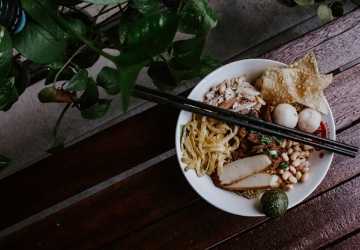How to Master the Art of Asian Fusion Cooking
Are you ready to take your culinary skills to the next level? Dive into the vibrant world of Asian fusion cuisine! Combining the rich flavors and techniques of various Asian cultures, Asian fusion recipes offer a deliciously unique twist on traditional dishes. Whether you're a seasoned chef or a home cook eager to experiment, mastering Asian fusion food will elevate your meals and impress your guests.
Are you ready to take your culinary skills to the next level? Dive into the vibrant world of Asian fusion cuisine! Combining the rich flavors and techniques of various Asian cultures, Asian fusion recipes offer a deliciously unique twist on traditional dishes. Whether you're a seasoned chef or a home cook eager to experiment, mastering Asian fusion food will elevate your meals and impress your guests.
Let's explore the secrets behind creating mouthwatering Asian fusion cuisine that will leave everyone craving more.
Understanding Asian Fusion Cuisine
Asian fusion cuisine is a style of cooking that combines ingredients and methods from various Asian cultures. It originated from the mingling of different Asian communities through trade, migration, and cultural exchange, leading to a culinary evolution that breaks traditional boundaries. This cuisine has grown popular in the West, where chefs experiment with Asian flavors to create new and exciting dishes.
Here are some of the key elements that distinguish Asian fusion recipes:
Diverse Ingredients
Asian fusion cuisine thrives on the rich variety of ingredients native to different Asian countries. By incorporating turmeric, cardamom, star anise, and galangal spices, dishes gain complex and aromatic profiles. Essential sauces like soy sauce, fish sauce, hoisin, and oyster sauce bring depth and umami to the recipes. Fusing these elements allows for endless culinary creativity, enabling chefs to craft unique dishes that celebrate the diversity of these cultures.
Innovative Techniques
The inventive use of traditional culinary techniques from various Asian cultures characterizes Asian fusion cooking. Stir-frying, a method widely used in Chinese cuisine, ensures quick cooking at high temperatures, preserving the texture and flavor of ingredients. Steaming, common in Japanese and Chinese kitchens, gently cooks food, maintaining its nutritional value and natural taste.
Flavor Balance
A hallmark of Asian fusion cuisine is its meticulous attention to balancing the five fundamental tastes: sweet, sour, salty, bitter, and umami. Sweetness can come from natural sources like honey, palm sugar, or fruits. Sour notes might be introduced through lime juice, tamarind, or vinegar. Salty flavors are often provided by soy sauce, fish sauce, or sea salt. Bitterness might be added with ingredients like bitter melon or certain greens. Umami, the savory taste, is typically achieved using mushrooms, miso, or fermented products.
Presentation
The presentation of Asian fusion dishes is an art form in itself, often influenced by the visual aesthetics of various Asian cultures. With its clean lines and understated elegance, Japanese minimalism emphasizes simplicity and the beauty of each ingredient. Plates are arranged thoughtfully, with attention to balance and harmony. In contrast, Thai cuisine often showcases vibrant colors and bold presentations, reflecting the dynamic and lively nature of the culture. Fresh herbs, edible flowers, and colorful vegetables are used to create visually stunning dishes.

Essential Ingredients for Asian Fusion Cooking
Asian fusion cooking relies on a diverse array of ingredients that form the foundation of many dishes. These staples include:
Soy Sauce
A versatile condiment that adds umami and saltiness to dishes. It's used in marinades, sauces, and stir-fries.
Fish Sauce
A potent sauce made from fermented fish is essential in Southeast Asian cooking. It adds depth and a savory note.
Rice Vinegar
Provides a mild acidity, perfect for balancing flavors in salads, pickles, and dipping sauces.
Sesame Oil
A fragrant oil used for seasoning and finishing dishes, imparting a rich, nutty flavor.
Coconut Milk
Widely used in Thai and Indian curries, it lends a creamy texture and subtle sweetness.
Miso Paste
A fermented soybean paste from Japan adds umami and complexity to soups, sauces, and dressings.
Ginger and Garlic
Fundamental aromatics form the base of many Asian dishes, adding warmth and pungency.
Must-Have Kitchen Tools
Having the right tools in your kitchen is essential is the key to mastering Asian fusion cooking. These tools make the cooking process more efficient and help achieve the authentic flavors and textures that define Asian fusion recipes. Here’s a detailed look at each must-have tool and its purpose:
Wok
A wok is versatile, distributes heat evenly, and is ideal for stir-frying, deep-frying, and steaming. Its high sides allow for quick cooking and easy tossing of ingredients, making it perfect for many Asian fusion dishes.
Rice Cooker
Ensures perfectly cooked rice every time, which is a staple in many Asian dishes. A rice cooker simplifies the cooking process, freeing you up to focus on preparing other components of your meal.
Mortar and Pestle
Essential for grinding spices and making pastes, providing a more authentic texture and flavor. This tool allows you to control the consistency of your ingredients and release their full aroma.
Bamboo Steamer
Bamboo steamers are perfect for steaming dumplings, vegetables, and fish, preserving nutrients and flavors. They stack easily, allowing you to cook multiple items simultaneously while keeping their flavors distinct.

Techniques and Methods Used in Asian Fusion Cuisine
Below, we explore the essential cooking methods that form the backbone of the vibrant culinary style of Asian cuisine and provide tips for seamlessly blending flavors and textures in your dishes.
Stir-Frying
Stir-frying is a quick cooking method that uses high heat and minimal oil. Ingredients are rapidly cooked in a wok, which allows them to retain their colors, flavors, and nutritional value. The constant motion ensures even cooking and prevents ingredients from sticking to the pan.
This technique is ideal for cooking vegetables, meats, and noodles, making it perfect for dishes like stir-fried rice, beef and broccoli, and pad Thai.
Steaming
Steaming is a gentle cooking method that uses steam to cook food, preserving its natural flavors, textures, and nutrients. Food is placed in a bamboo or metal steamer over boiling water, allowing the steam to circulate and cook the food evenly.
It is commonly used for cooking delicate items like fish, dumplings, and vegetables. Steaming is essential in dishes such as Chinese steamed fish, shumai, and various steamed vegetables, ensuring they remain moist and flavorful.
Blanching
Blanching involves briefly boiling vegetables in water and then quickly transferring them to ice water to stop the cooking process.
It is mainly used as a preparatory step for stir-frying or as part of a salad. Blanching is ideal for green beans, broccoli, and snow peas, ensuring they stay bright and tender-crisp.
Deep-Frying
This method effectively achieves the crunchy texture often sought after in Asian cuisine. It is most suited for foods like spring rolls, tempura, and fried wontons.
Conclusion
Asian fusion cuisine offers an exciting adventure in taste and technique, blending the best of various Asian traditions. With the right ingredients and tools, you can create dishes that are as delightful to the eye as they are to the palate. Begin exploring and see where your culinary curiosity takes you!





